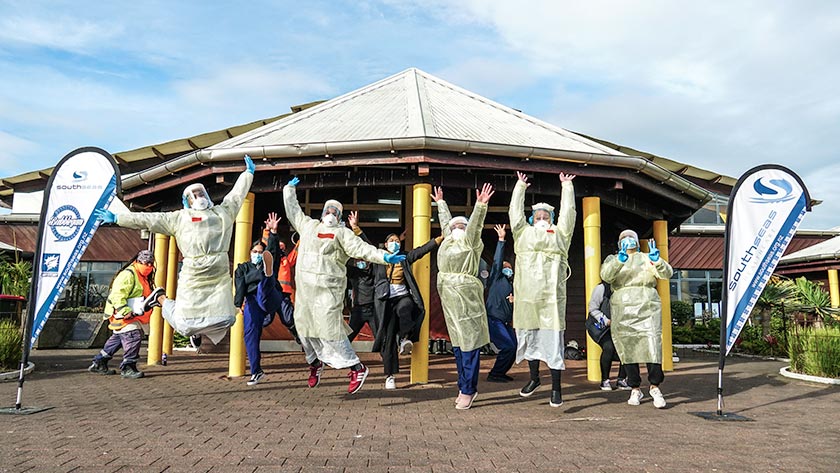
Decades of disinvestment and serious staffing shortages led to strike action in the district health board sector in June. Efforts by the entire NZNO team and members to ensure the strike was well-planned and went ahead successfully was an event we can now look back on with a real sense of achievement – it was massive and ultimately did reach the needed outcome.
Effective implementation of the safe staffing tool, care capacity demand management (CCDM), however, remains a major challenge, with the announcement of a ministerial review in September into why only half the country’s DHBs had implemented it by the June deadline. NZNO members and staff have been interviewed as part of the review and a report is expected by the end of 2021.
Since COVID-19 management strategies commenced in 2020, nurses have been at the forefront of the response. Our work has been done in an environment of chronic and serious understaffing across all sectors, with closed borders and the usual flow of internationally qualified staff on whom the health-care system is so reliant, suddenly severely limited. Nurses across all sectors and around Aotearoa have been mobilised to protect borders and communities, and to test, vaccinate and care for people with COVID-19 symptoms, both in the community and in hospital. Reaching the 90 per cent vaccination goal in greater Auckland, Tāmaki Makaurau, and getting so close nationally has been a huge achievement.
Our work has been done in an environment of chronic and serious understaffing across all sectors, with closed borders and the usual flow of internationally qualified staff… suddenly severely limited.
The lack of preparedness in the health sector has emerged as a major concern. Plans for a surge workforce have been hampered by underlying staff vacancies which have meant that staff could not, in many cases, be released to undertake the practical component of the intensive care unit (ICU) training. And these nurses are no substitute for experienced ICU nurses but rather a crisis management workforce.
Unlike other jurisdictions, New Zealand has not thus far seen the overwhelming numbers of people requiring critical support, including ventilation. The admission rates to hospital for COVID-related infections have not been as high as some predictions.
Community quarantine
However, there are an ever-increasing number of people requiring isolation or quarantine in their homes – community-supported isolation/quarantine (CIQ).
In October the number of those isolating in their home was in the thousands. Nurses are providing care remotely to this large and potentially very vulnerable group of patients.
This is separate to the virtual ward – a hospital in the home – set up to manage those patients with COVID-19 who are below the threshold for hospital admission but may still be very unwell.
The high vaccination rates in the community have been protective against high numbers of hospital admissions, but the capacity and capability of community/primary care to manage growing numbers is a new challenge to navigate.
Such challenges may be seen on a national level as community cases are identified throughout the country.
There is growing use of technologies to support this remote care, such as telehealth and remote monitoring. This is a rapidly growing area of practice, being acknowledged by the Nursing Council in its future competencies around emerging nursing skills.
With whole new areas of nursing expertise emerging, such changes in practice will be lasting, as we contemplate how we manage patients in the future, post-pandemic.
Health reforms
Against this backdrop of what has now become endemic COVID-19 in the community, the most significant health reforms Aotearoa has seen in decades are unfolding. The Pae Ora (Healthy Futures) Bill was introduced in October and has had its first reading. It takes effect in July 2022, replacing the NZ Health and Disability Act 2000.
What is in the healthy futures bill?
- Establishing a Māori Health Authority.
- Moving parts of the Ministry of Health (MoH) to Health New Zealand (HNZ), which will take over management of all health services.
- HNZ will replace the Health Promotion Agency and all 20 district health boards.
- A new policy on the overall direction, priorities and objectives for the health system.
- A health strategy for the next five-10 years and
- A health plan on how to implement it agreed by HNZ and the Māori Health Authority.
- A locality plan to assess health needs in communities, a charter for organisations and workers in the health system and a code to encourage consumer voice.
- A new public health agency within the MoH to provide leadership and advice.
The changes are huge, of a magnitude not seen since crown health enterprises and regional health authorities were set up in the 1990s. Lessons need to be taken from that period, as the changes at that time were detrimental to nursing leadership.
It is imperative that where nurses do have the ability to influence or be involved in the changing face of health-care delivery, that we do so.
Disappointingly, there are no nurses on either the Transition Unit or the Maori Health Authority. It is imperative that where nurses do have the ability to influence or be involved in the changing face of health-care delivery, that we do so – whether it is being part of a working group or in submissions to the Bill as it goes through its various stages over coming months.
In a year that has been so challenging, it is important to reflect on those things that have been achieved, whether at a local or national level, and to take time to celebrate successes – no matter how small. Thank you to all NZNO members, wherever you are working, for all that you have done this year in support of better health outcomes.



